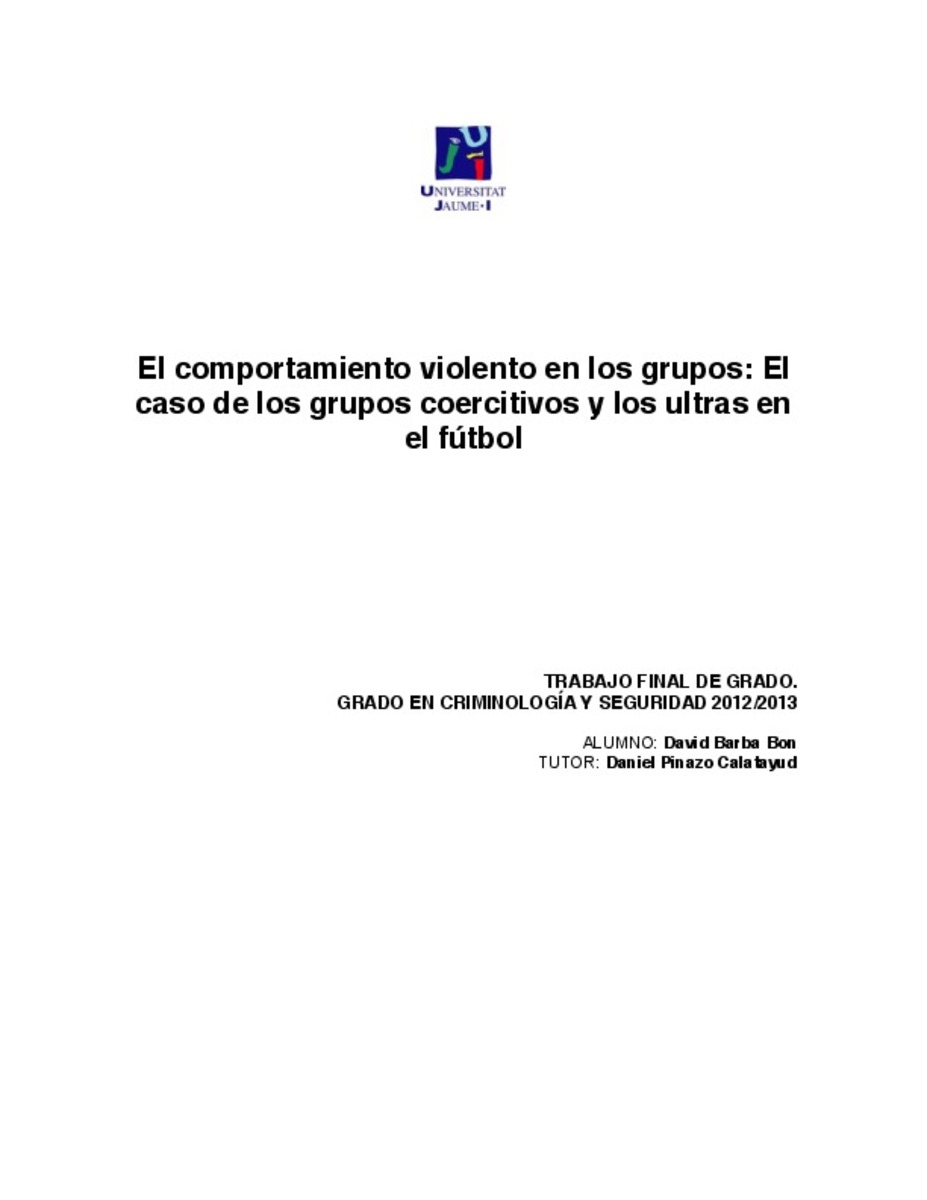| dc.contributor | Pinazo Calatayud, Daniel | |
| dc.contributor | Universitat Jaume I. Departament de Psicologia Evolutiva, Educativa, Social i Metodologia | |
| dc.contributor.author | Barba Bon, David | |
| dc.date.accessioned | 2014-09-22T11:34:48Z | |
| dc.date.available | 2014-09-22T11:34:48Z | |
| dc.date.issued | 2014-07-14 | |
| dc.identifier.uri | http://hdl.handle.net/10234/103095 | |
| dc.description | Treball Final de Grau en Criminologia i Seguretat. Codi: CS1044. Curs 2013-2014 | ca_CA |
| dc.description.abstract | Los miembros que componen un determinado grupo comparten normas, valores, formas de percibir la sociedad, actitudes, etc. Se forman bien porque de manera individual consideran que con su pertenencia verán satisfechas sus necesidades, bien porque el sujeto siente atracción hacia sus miembros o hacia las actividades que el grupo realiza, porque considera valiosos los objetivos que persigue o por el simple hecho de sentirse integrado en un grupo con otros miembros con los que compartir actividades. Para la consecución de sus objetivos se establece una estructura, ya sea de manera formal o informal, en la que se establecen las diferentes posiciones y funciones de los miembros dentro del grupo u las pautas o reglas de conducta.
En grupos violentos los miembros del grupo están dominados por líderes autoritarios. La obediencia ciega hacia éstos y los procesos de influencia grupal provocan que los individuos se dejen llevar por las normas del grupo, se conformen con las conductas realizadas por la mayoría y que terminen pensando que la norma del grupo es la única vía de hacer las cosas.
En los grupos coercitivos se consigue esa dominación mediante la utilización de técnicas manipulativas dirigidas a controlar la voluntad de los adeptos e imponerles su ideología por medio de un proceso de adoctrinamiento en el que se aísla al sujeto de su entorno anterior para que su única influencia sea la que marca el grupo, adoptándose así la identidad de éste.
En el caso de los ultras en el fútbol, en cambio, comenzaron adoptando esas posturas violentas como actos de rebeldía social o como instrumento para reivindicar posiciones políticas, sin embargo la violencia se ha normalizado hasta el punto de su utilización como algo que genera satisfacción a sus miembros, una pauta de conducta que hay que seguir para formar parte del mismo y de la que no te puedes desviar. | ca_CA |
| dc.description.abstract | Members of a particular group shared norms, values, ways of perceiving the society, attitudes, etc... The groups are well formed because individually consider that with their belonging will see their needs satisfied, either because the individual is attracted by the members or is attracted by the activities realized by the group; or because is considered valuable the objectives pursued, or simply because feeling integrated into a group with other people who share time and activities. To achieve their objectives a structure is established, either in a formal or informal manner, where the different positions are established as well as the roles of the members within the group and the guidelines or rules of conduct.
In violent groups, members are dominated by autoritary leaders. The mindless obedience towards these leaders and the influence group processes cause the individuals get carried away by the group norms, the individuals are conformed with the behaviors of the majority and they finish thinking that the rule of the group is the only route of doing things.
In coercive groups such domination is achieved through the use of manipulative techniques designed to control the will of the followers and impose their ideology through a process of indoctrination in which the individual is isolated from his former environment so its unique influence is which marks the group, thereby adapting the identity of the group.
In the case of ultra-groups in football, in contrast, they started adopting these violent attitude as acts of social revelation or as an instrument to vindicate political positions, nevertheless violence in these ultra-groups has been normalized to the point of use as something that generates its members satisfaction, a pattern of conduct that should be followed to be part of the group and that cannot divert. | ca_CA |
| dc.format.extent | 47 p. | ca_CA |
| dc.format.mimetype | application/pdf | ca_CA |
| dc.language.iso | spa | ca_CA |
| dc.publisher | Universitat Jaume I | ca_CA |
| dc.rights | Attribution-NonCommercial-NoDerivs 4.0 Spain | * |
| dc.rights.uri | http://creativecommons.org/licenses/by-nc-nd/4.0/ | * |
| dc.subject | Grau en Criminologia i Seguretat | ca_CA |
| dc.subject | Grado en Criminología y Seguridad | ca_CA |
| dc.subject | Bachelor's Degree in Criminology and Security | ca_CA |
| dc.subject | groups | ca_CA |
| dc.subject | lead | ca_CA |
| dc.subject | hooligans | ca_CA |
| dc.subject | influence | ca_CA |
| dc.subject | fan | ca_CA |
| dc.subject | violence | ca_CA |
| dc.subject | identity | ca_CA |
| dc.subject | sect | ca_CA |
| dc.subject | coercive group | ca_CA |
| dc.subject | grupos | ca_CA |
| dc.subject | líder | ca_CA |
| dc.subject | influencia | ca_CA |
| dc.subject | hincha | ca_CA |
| dc.subject | ultra | ca_CA |
| dc.subject | violencia | ca_CA |
| dc.subject | identidad | ca_CA |
| dc.subject | secta | ca_CA |
| dc.subject | grupo coercitivo | ca_CA |
| dc.title | El comportamiento violento en los grupos: El caso de los grupos coercitivos y los ultras en el fútbol | ca_CA |
| dc.type | info:eu-repo/semantics/bachelorThesis | ca_CA |
| dc.educationLevel | Estudios de Grado | ca_CA |
| dc.rights.accessRights | info:eu-repo/semantics/openAccess | ca_CA |








